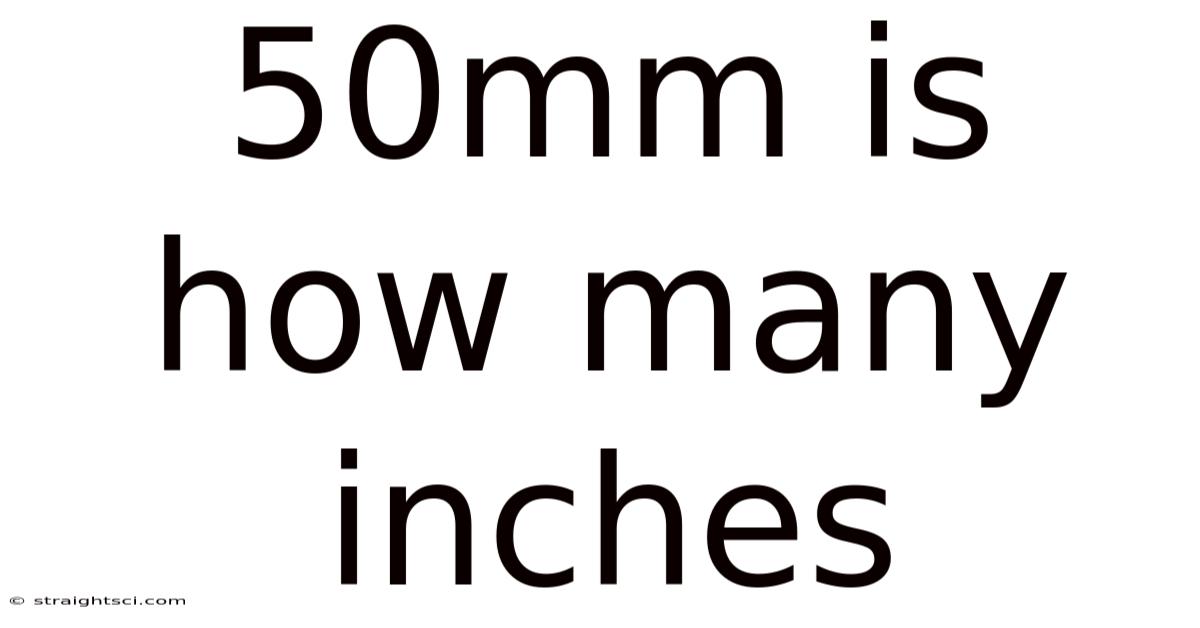50mm Is How Many Inches
straightsci
Aug 26, 2025 · 4 min read

Table of Contents
50mm is How Many Inches? A Comprehensive Guide to Metric-Imperial Conversion
Understanding the relationship between metric and imperial units is crucial in many fields, from engineering and manufacturing to everyday life. Frequently, the need to convert between millimeters (mm) and inches arises. This comprehensive guide will not only answer the question, "50mm is how many inches?" but will also delve into the underlying principles of unit conversion, provide practical examples, and equip you with the tools to confidently handle similar conversions in the future. We will explore the mathematics behind the conversion, discuss common applications, and address frequently asked questions.
Understanding the Conversion Factor
The core of converting between millimeters and inches lies in understanding their relationship. One inch is defined as exactly 25.4 millimeters. This conversion factor is the key to all our calculations. To convert millimeters to inches, we will divide the millimeter value by 25.4. Conversely, to convert inches to millimeters, we multiply the inch value by 25.4.
Calculating 50mm in Inches
Let's answer the central question: 50mm is how many inches?
Using the conversion factor, we perform the following calculation:
50 mm / 25.4 mm/inch ≈ 1.97 inches
Therefore, 50 millimeters is approximately 1.97 inches. It's important to note that this is an approximation due to rounding. The exact value is a recurring decimal.
Beyond the Calculation: A Deeper Dive into Unit Conversion
The conversion from millimeters to inches isn't just about plugging numbers into a formula; it's about understanding the fundamental principles of measurement systems. Let's explore this further.
-
Metric System (SI Units): The metric system, also known as the International System of Units (SI), is a decimal system based on powers of 10. This makes conversions within the system straightforward. For instance, converting from millimeters to centimeters involves simply dividing by 10 (10 mm = 1 cm). The system's consistency simplifies calculations and reduces errors.
-
Imperial System: The imperial system, used primarily in the United States, is a less consistent system with varied conversion factors between units. This lack of consistency can make conversions more complex and prone to errors.
-
The Importance of Precision: In certain fields like engineering and manufacturing, precise conversions are paramount. Small discrepancies can lead to significant issues. Therefore, using more decimal places in calculations might be necessary, depending on the required level of accuracy. Using tools like online converters or scientific calculators can help achieve this higher level of precision.
-
Common Applications: Converting between millimeters and inches is relevant in various contexts:
- Engineering and Design: Converting blueprints and specifications between metric and imperial systems is a frequent task.
- Manufacturing: Ensuring proper dimensions and tolerances requires accurate conversions.
- Construction: Working with materials sourced from different countries might require conversion between these systems.
- Everyday Life: Understanding these conversions helps in situations such as comparing screen sizes or choosing the right size clothing, particularly when dealing with items imported from countries using different measurement systems.
Practical Examples of mm to Inches Conversion
Let's look at a few more examples to solidify our understanding:
- Converting 100mm to inches: 100 mm / 25.4 mm/inch ≈ 3.94 inches
- Converting 20mm to inches: 20 mm / 25.4 mm/inch ≈ 0.79 inches
- Converting 150mm to inches: 150 mm / 25.4 mm/inch ≈ 5.91 inches
Working with Different Units within the Metric System
While our focus is on converting millimeters to inches, understanding the relationships within the metric system is equally important. Remember that:
- 1 meter (m) = 100 centimeters (cm)
- 1 centimeter (cm) = 10 millimeters (mm)
- 1 kilometer (km) = 1000 meters (m)
This hierarchical structure allows for easy conversion within the metric system. For example, if you need to convert 500 millimeters to meters, you would divide by 1000 (500 mm / 1000 mm/m = 0.5 m).
Frequently Asked Questions (FAQ)
Q: Is there a simple formula I can use for mm to inches conversion?
A: Yes, the formula is: Inches = Millimeters / 25.4
Q: Why is 25.4 used as the conversion factor?
A: This is the internationally agreed-upon definition, establishing the precise relationship between millimeters and inches.
Q: Are online conversion tools reliable?
A: Generally, yes, provided you choose reputable websites. However, always double-check your calculations, especially in situations requiring high precision.
Q: What if I need to convert inches to millimeters?
A: The formula for this is: Millimeters = Inches * 25.4
Q: Are there any potential sources of error in these conversions?
A: Rounding errors can occur. For highly precise applications, use a calculator that allows for more decimal places or employ specialized conversion software. Also ensure you're using the correct conversion factor (25.4).
Conclusion: Mastering Metric-Imperial Conversions
Converting 50mm to inches, as we've seen, is a straightforward process once you understand the fundamental conversion factor. However, this extends beyond a simple calculation. Mastering these conversions requires a grasp of both the metric and imperial systems, an understanding of the conversion factor’s significance, and an awareness of potential sources of error. The ability to confidently switch between these units is a valuable skill with broad applications in numerous fields, from everyday tasks to specialized professional work. Remember to always double-check your calculations and choose the appropriate level of precision based on the context of your work. With practice, you’ll become proficient in handling these conversions and navigating the world of measurements with ease.
Latest Posts
Related Post
Thank you for visiting our website which covers about 50mm Is How Many Inches . We hope the information provided has been useful to you. Feel free to contact us if you have any questions or need further assistance. See you next time and don't miss to bookmark.